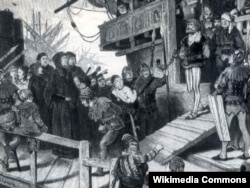The German port city of Hamburg is proud of its pirate history. Built at the confluence of the Elbe, Alster, and Bille rivers, and situated close to the main trade routes to the North and Baltic seas, Hamburg was a frequent target of pirates in centuries past.
Today, many in Hamburg harbor romantic associations with pirates, who are remembered in legends and myths as bold, populist heroes willing to defy authority.
A statue of the city's most famous 14th-century pirate, Klaus Stoertebeker, stands in a city park. A group of political renegades recently established a so-called Pirates Party, claiming to represent the interest of pirates and making a series of tongue-in-cheek pledges.
But Hamburg's love affair with the pirates of yore has suddenly bumped against modern-day reality, as the city prepares for its first piracy trial in 400 years. The defendants are 10 Somali men, arrested after they attacked a German cargo ship off the Somali coast in April.
The men, who were captured by Dutch navy commandos, are to face charges of hijacking the German ship and holding hostage its crew, who were eventually released unharmed. The trial -- Germany's first involving suspected Somali pirates -- is due to begin in the next few months.
The details of the "real" piracy case have clashed with many Hamburgers' idealized notion of the rebellious and defiant sea warriors.
Brita Nibuhr, a librarian with Hamburg's Altona arts and cultural history museum, says that piracy is sufficiently "shrouded in mystery and romance" that a Pirates Party ran a spirited, if unsuccessful, campaign in Hamburg's regional elections in 2008.
"We were wondering what this was -- a joke, role-playing, or what," Nibuhr says. "They tried to exploit this romantic image of a pirate, saying they opposed all forms of oppression. If people voted for them, they pledged to throw a big feast and give everyone free beer. And perhaps there were people who found this idea entertaining -- and voted for them."
Headless 'Hero'
The figure that crystallized the romantic stereotype of pirates, and whose name became inseparable from Hamburg's history, was Stoertebeker. The scourge of all trading ships that ventured near the city, Stoertebeker -- whose name, roughly translated, means "tipping a mug" -- was a prodigious drinker.
He was also a highly effective bandit who earned a reputation as a Robin Hood of the high seas for his habit of dividing the plunder equally among his mates and -- as some stories hold -- even sharing it with the poor.
Stoertebeker, who initially worked with the protection of the Swedish king, soon began to flaunt his independence and became uncontrollable, robbing many ships and hindering trade. The authorities decided to act, and Stoertebeker and his fellow pirates were arrested.
Legends about Stoertebeker extend to his beheading in 1400 on Hamburg's central square, when he reputedly attempted to walk, headless, past a row of his fellow condemned pirates. The feat was meant to secure the release of his mates, but according to myth, the executioner deliberately tripped Stoertebeker, and all of the pirates were eventually killed.
Stoertebeker was back in the news this year, when it was reported that a 600-year-old skull believed to have belonged to the legendary pirate had disappeared from the Hamburg history museum. His story has been part of the pirate craze that has seized much of the world in recent decades, popularized by tales of Long John Silver and Blackbeard, and, more recently, by the "Pirates of the Caribbean" Disney movie franchise.
Trying Times
But the Somali attack on "Taipan," a German merchant ship some 700 kilometers off the Somali coastline in April, has changed many Hamburgers' view of pirates. Previously, pirates detained near the Somali coastline -- a hotspot of international piracy -- have been tried in Kenya.
But Kenyan authorities, inundated with cases, have announced that the fate of pirates and hijackers should now fall to the country where the affected ship is registered. (In the wake of a similar incident, Russia, for example, opted to simply release a group of pirates onto the open sea, where a high-level Russian source later conceded they had probably died.)
At Germany's request, the 10 suspected pirates were delivered on June 11 to Hamburg, where they remain in preliminary custody. Wilchelm Moellers, a press officer with the city prosecutor's office, says one of the suspects is said to be only 15 years old.
"When the arrest warrant was being read to them, the young one started to cry," Moellers says. "The rest kept their cool. I would not say they were disinterested, but they managed to keep a straight face."
The case, Moellers says, will be handed over in autumn to a court, where the suspects will be tried in accordance with German law. If found guilty, they face sentences of up to 15 years in prison.
So is it a paradox that Hamburg, on the one hand, immortalizes the romantic image of piracy and, on the other, subjects modern-day pirates to a possibly harsh and lengthy sentence?
"Legend portrays Stoertebeker as a rebel, and surprisingly, in contemporary fiction, too, pirates are represented as positive figures who stand up to the powerful," librarian Nibuhr says. "But the Stoertebeker legend has nothing to do with the threat that international piracy creates for sailors today. A protagonist of a legend is one thing. The real problem is quite another. [The pirates], undoubtedly, are criminals."
Today, many in Hamburg harbor romantic associations with pirates, who are remembered in legends and myths as bold, populist heroes willing to defy authority.
A statue of the city's most famous 14th-century pirate, Klaus Stoertebeker, stands in a city park. A group of political renegades recently established a so-called Pirates Party, claiming to represent the interest of pirates and making a series of tongue-in-cheek pledges.
But Hamburg's love affair with the pirates of yore has suddenly bumped against modern-day reality, as the city prepares for its first piracy trial in 400 years. The defendants are 10 Somali men, arrested after they attacked a German cargo ship off the Somali coast in April.
The men, who were captured by Dutch navy commandos, are to face charges of hijacking the German ship and holding hostage its crew, who were eventually released unharmed. The trial -- Germany's first involving suspected Somali pirates -- is due to begin in the next few months.
The details of the "real" piracy case have clashed with many Hamburgers' idealized notion of the rebellious and defiant sea warriors.
Brita Nibuhr, a librarian with Hamburg's Altona arts and cultural history museum, says that piracy is sufficiently "shrouded in mystery and romance" that a Pirates Party ran a spirited, if unsuccessful, campaign in Hamburg's regional elections in 2008.
"We were wondering what this was -- a joke, role-playing, or what," Nibuhr says. "They tried to exploit this romantic image of a pirate, saying they opposed all forms of oppression. If people voted for them, they pledged to throw a big feast and give everyone free beer. And perhaps there were people who found this idea entertaining -- and voted for them."
Headless 'Hero'
The figure that crystallized the romantic stereotype of pirates, and whose name became inseparable from Hamburg's history, was Stoertebeker. The scourge of all trading ships that ventured near the city, Stoertebeker -- whose name, roughly translated, means "tipping a mug" -- was a prodigious drinker.
He was also a highly effective bandit who earned a reputation as a Robin Hood of the high seas for his habit of dividing the plunder equally among his mates and -- as some stories hold -- even sharing it with the poor.
Stoertebeker, who initially worked with the protection of the Swedish king, soon began to flaunt his independence and became uncontrollable, robbing many ships and hindering trade. The authorities decided to act, and Stoertebeker and his fellow pirates were arrested.
Legends about Stoertebeker extend to his beheading in 1400 on Hamburg's central square, when he reputedly attempted to walk, headless, past a row of his fellow condemned pirates. The feat was meant to secure the release of his mates, but according to myth, the executioner deliberately tripped Stoertebeker, and all of the pirates were eventually killed.
Stoertebeker was back in the news this year, when it was reported that a 600-year-old skull believed to have belonged to the legendary pirate had disappeared from the Hamburg history museum. His story has been part of the pirate craze that has seized much of the world in recent decades, popularized by tales of Long John Silver and Blackbeard, and, more recently, by the "Pirates of the Caribbean" Disney movie franchise.
Trying Times
But the Somali attack on "Taipan," a German merchant ship some 700 kilometers off the Somali coastline in April, has changed many Hamburgers' view of pirates. Previously, pirates detained near the Somali coastline -- a hotspot of international piracy -- have been tried in Kenya.
But Kenyan authorities, inundated with cases, have announced that the fate of pirates and hijackers should now fall to the country where the affected ship is registered. (In the wake of a similar incident, Russia, for example, opted to simply release a group of pirates onto the open sea, where a high-level Russian source later conceded they had probably died.)
At Germany's request, the 10 suspected pirates were delivered on June 11 to Hamburg, where they remain in preliminary custody. Wilchelm Moellers, a press officer with the city prosecutor's office, says one of the suspects is said to be only 15 years old.
"When the arrest warrant was being read to them, the young one started to cry," Moellers says. "The rest kept their cool. I would not say they were disinterested, but they managed to keep a straight face."
The case, Moellers says, will be handed over in autumn to a court, where the suspects will be tried in accordance with German law. If found guilty, they face sentences of up to 15 years in prison.
So is it a paradox that Hamburg, on the one hand, immortalizes the romantic image of piracy and, on the other, subjects modern-day pirates to a possibly harsh and lengthy sentence?
"Legend portrays Stoertebeker as a rebel, and surprisingly, in contemporary fiction, too, pirates are represented as positive figures who stand up to the powerful," librarian Nibuhr says. "But the Stoertebeker legend has nothing to do with the threat that international piracy creates for sailors today. A protagonist of a legend is one thing. The real problem is quite another. [The pirates], undoubtedly, are criminals."















